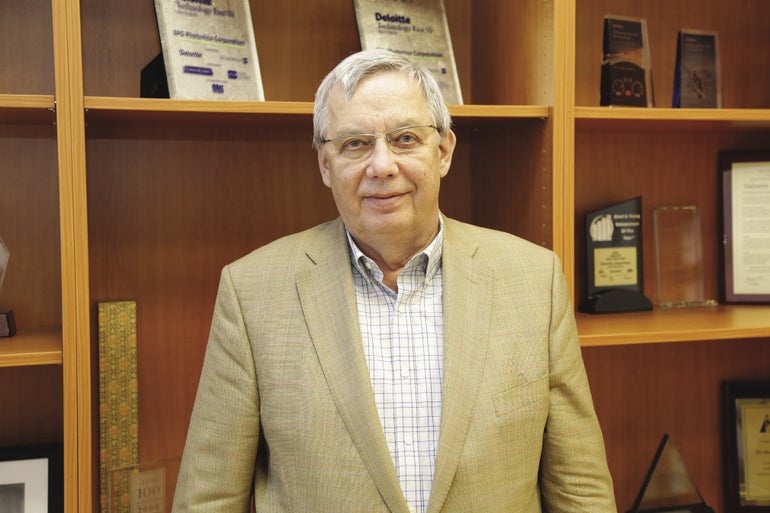
IPG Photonics of Oxford controls 80 percent of the world’s fiber laser market and is able to sell high-powered lasers for less than what it costs competitors to make them.
But the path to its prosperity hasn’t been easy for Valentin Gapontsev, IPG’s founder and CEO.
The company was founded in 1990 in the basement of a small laboratory near Moscow. Gapontsev, then 52, had just a few thousand dollars in savings and no experience in business management since he had spent his entire life in the Soviet Union, where private enterprise was outlawed.
Gapontsev said he was isolated in IPG’s early years, receiving no help or advice, not even assistance with language as the native Russian speaker expanded the company into Italy in 1994.
“We fought to survive,” he said.
But what Gapontsev lacked in money or experience, he made up for in expertise. He had spent a quarter-century as a materials scientist at the Soviet Academy of Sciences, becoming known worldwide for his research into laser materials.
That allowed him to spot the potential in lasers based on fiber optics, even though they could only achieve limited amounts of power at that time.
“Very smart people in the industry did not believe technically it was possible,” said Felix Stukalin, IPG’s senior vice president of U.S. operations. “Valentin was willing to take significant personal risks based on his intuition.”
The risk paid off, albeit slowly at first, as Gapontsev demonstrated it was possible to produce high-powered fiber lasers. With time, he said, more companies started to trust and use the technology.
“Out of 100 people, you only need one or two customers (to sign a contract),” Gapontsev said.
Gapontsev’s quest for new clients brought him across the Atlantic to the U.S., specifically Central Massachusetts, where he inked his first successful U.S. contract with fiber-optic equipment maker Galileo Corp. of Sturbridge. However, Galileo went bankrupt in 1998 and laid off its workers.
Gapontsev saw this as his chance to get a physical presence in America, a necessity to conduct business with companies that work on government contracts. So he brought several ex-Galileo people onboard, rented a couple of rooms in Sturbridge and launched IPG’s American operations in December 1998 with 17 people.
Of those 17, 11 are still with the company, Gapontsev said.
IPG doubled-down on its North America division in 2000, when the company received its first round of private investment. As a condition of that investment — which included a sale of 8 percent of the company for $100 million — Gapontsev said IPG agreed to move its ownership and headquarters from Germany to the U.S.
Expert positioning
Many of IPG’s early employees lived in the Springfield area (the company had 100 workers by 2000), Gapontsev said, which took Greater Boston out of the picture as a headquarters option. So IPG settled in Oxford, after spotting a secluded vacant lot off a residential road and receiving a 20-year tax increment financing agreement.
Then the dot-com bubble burst, drying up capital from telecom companies that fed the builders of fiber-optic broadband networks. IPG’s revenue, in turn, fell 60 percent to just $22 million in 2002.
That’s when Gapontsev adopted what analysts hail as his crowning achievement: vertical integration.
IPG invested most of its remaining money into a high-volume production facility so all raw components for the lasers could be produced in-house. That allowed the company to cut its production costs nearly 90 percent while improving the quality of its work.
“IPG isn’t outsourcing their production, so nobody else knows what they’re doing,” said Joe Maxa, an analyst at Minneapolis-based Dougherty & Co. “We believe they are several years ahead of the competition.”
Gapontsev took the company public in 2006 to repay his early investors and began work on a 101,500-square-foot expansion in Oxford in 2011.
That physical growth has been accompanied by payroll growth. IPG’s Oxford-based workforce has expanded from 420 in October 2010 to more than 900 today, Stukalin said, while revenue has grown over the past year from $562.5 million to $648 million.
Minimum management, maximum effort
Throughout it all, two things have remained constant with Gapontsev at the helm: lean management and long hours for employees.
Gapontsev said he keeps upper and middle management to a bare minimum, with only a general manager and financial director overseeing 1,000 workers in Germany. This structure allows for more staffing in production and development units and prevents decisions from getting bogged down in endless meetings or debate.
Video
Business Leaders of the Year 2014 – Valentin Gapontsev, IPG Photonics
Read more
IPG Posts Record Revenue For 3rd Quarter
Flush with cash: Public firms raking in profits, hanging onto cash

